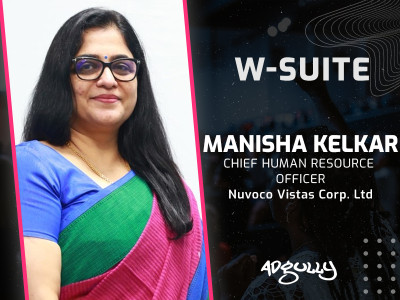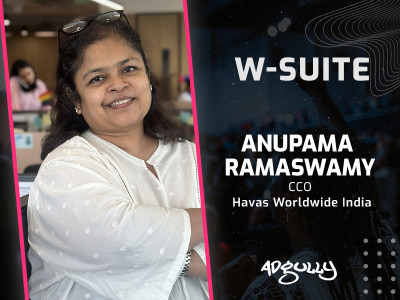The pandemic has been yet another testament to women’s leadership: Twishy Vats
We, at Adgully, have always saluted and honoured women managers and leaders across diverse fields. W-SUITE is a special initiative from Adgully that has been turning the spotlight on some of the most remarkable women achievers in M&E, Advertising & Marketing, PR & Communication industry. In the refurbished series, we seek to find out how women leaders have been managing their teams and work as well as how they have been navigating through the toughest and most challenging times brought about by the global pandemic.
Twishy Vats is the Chief Content Officer at Inshorts. Having worked with Inshorts for the past six years, she oversees the content creation team for both the platforms – Inshorts, India’s #1 English news app and Public app, India’s largest location-based social network and #1 app for vernacular video updates. She is also responsible for creating a brand message and structure that stays consistent in all the messaging.
In conversation with Adgully, Twishy Vats, Chief Content Officer, Inshorts Group, speaks about the many challenges and opportunities brought forth by the global pandemic, how empathetic women leaders are multi-managing the crises , lessons that she learnt as a woman leader and more.
How do you think the role and scope of women leaders have widened in the post-pandemic world?
Over the past two years, the pandemic has brought with it a unique set of challenges along with several learning opportunities. Women leaders have surfed through these unchartered waters and emerged successfully. From the shift to remote working to living in an ever-evolving digital world – our work, as well as personal lives, have constantly changed.
I believe the merging of geographical restrictions in a pandemic-induced remote working model has led to a sharp increase in opportunities for women. Coupled with flexible work schedules, it has helped women leaders to overcome challenges and grasp newer opportunities like never before. A lot of women who had to leave their jobs to be the caregivers of their families are now returning to the workforce as they can now customise their schedules and easily manage all aspects of their lives.
The rapid transition to digital, an uncertain economic landscape, charting unknown waters, working from home – how have you been navigating during the COVID-19 times? How are you maintaining work-life balance in the new normal?
The pandemic was an unprecedented and unforeseeable global event, something that we were untrained for, still we strived through it. In the initial days, balancing personal life and a remote work set-up, all combined with the worries of a global public-health crisis, was daunting, to say the least. Gradually, I started settling in the new normal, as we now call it. Over time, I developed a new work routine and strategy to keep the momentum going. One extremely crucial practice to maintain a healthy work-life balance is establishing boundaries. The personal and professional aspects of our lives shouldn’t get heavier on each other, and these boundaries ensure that we achieve the desired balance.
We are a content app, so managing and pushing out the correct information at a time when so much was happening was a challenge. The entire team had to work together and double verify each information so as to avoid spreading fake news. But as time passed, we adapted to the new normal by implementing new processes and strategies of working efficiently in a remote environment.
Multiple studies have shown how women leaders performed better during the COVID-19 crisis. According to you, what makes women the best in crisis management?
The pandemic has been yet another testament to women’s leadership. Countries led by women leaders have been particularly successful in fighting COVID-19. As women, we face different kinds of adversities throughout our lives. It is these challenges that women wear as a suit of armour to face the world. Hence, I feel, we learn how to handle a crisis quite early in our lives. Perseverance and calmness built over the years have helped women leaders stay composed in these adverse conditions. Moreover, the pandemic called for a workplace that prioritised employees’ well-being by understanding their problems. This called for empathetic leaders who could multi-manage various challenges, and it’s safe to say that women leaders across the world rose to the occasion.
What are the five most effective lessons that you have learned as a woman leader?
Some key life lessons I have imbibed from my professional journey are:
- Communicate: Speak up for things you are passionate about, and ideas you don’t like. You won’t risk your seat at the table by standing up and communicating what you think. Holding back will be a hurdle to your growth. Ask for what you want.
- Be yourself: Everyone has their unique leadership style, and you should not be scared of embracing yours. No rule book defines a good leader, so create your own rules as you go.
- Keep learning: We live in tumultuous times, and each day is a new challenge. Keep upskilling and reskilling to keep your skillset relevant. Learning never stops and when you think there is nothing to learn, think more.
- Show empathy: Women are often labeled as the more emotional gender. Remember that showcasing emotions and being passionate does not make you a less efficient leader. Rather, it makes you more humane. Emotions can be an asset, and empathy is what we need in these times. Don’t run away from it.
- Motivate your team: Over the years, I have learnt that as important as it is to guide and lead the people you work with, it is equally important to establish a connection with them and uplift them through affirmative words. A ‘good job’ goes a long way! As the popular saying goes, people may not remember what you say, but they will remember how you made them feel.
Gender sensitivity and inclusion in the new normal – how can organisations effectively encourage and groom women leaders in challenging times?
Though gender sensitivity and inclusion in the workplace have become omnipresent conversations, we still have a long way to go. Organisations should look beyond the gender of a candidate and focus on the skills, capability, intelligence, experience, and performance. I am a strong believer of ‘equal pay for equal work’ as it encourages more women to join the workforce.
If you want to build a stronger and wholly inclusive workplace, give women room for growth, listen to their ideas, and you will be surprised to see what they are capable of.

















Share
Facebook
YouTube
Tweet
Twitter
LinkedIn